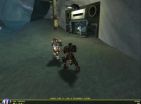(Press-News.org) GAINESVILLE, Fla. --- A small African mammal with an unusual ability to regrow damaged tissues could inspire new research in regenerative medicine, a University of Florida study finds.
For years biologists have studied salamanders for their ability to regrow lost limbs. But amphibian biology is very different than human biology, so lessons learned in laboratories from salamanders are difficult to translate into medical therapies for humans. New research in the Sept. 27 issue of the journal Nature describes a mammal that can regrow new body tissues following an injury. The African spiny mouse could become a new model for research in regenerative medicine.
"The African spiny mouse appears to regenerate ear tissue in much the way that a salamander regrows a limb that has been lost to a predator," said Ashley W. Seifert, a postdoctoral researcher in UF's biology department. "Skin, hair follicles, cartilage -- it all comes back."
That's not the case in other mammals, he said. Usually scar tissue forms to fill the gap created by a wound.
The spiny mouse also regrows tissue on its main body when injured but not as completely as it does in its ears. "On their backs, they regrow hair follicles and skin, but the muscle beneath the skin doesn't regenerate," Seifert said.
Seifert was studying scar-free healing in amphibians when a colleague told him that a small rodent he had observed in Africa seemed capable of autotomy, a defense mechanism whereby the animal self-amputates a body part to escape a predator.
"Autotomy in skinks, geckos and some salamanders is well known," Seifert said. "But it is very rare in mammals, and so far we've only seen it in a few rodents that can jettison their tail."
Seifert's colleague said that the African spiny mouse appeared to have tear-away skin that allowed it to slip a predator's grasp. The notion was interesting enough to send Seifert packing to the Mpala Research Centre near Nairobi, Kenya.
In Nairobi, Seifert was able to document the first known case of skin autotomy in a mammal. But it was how the animals' injuries appeared to be healing that really got his attention.
Seifert used a 4mm biopsy punch, about the size of a large BB, to puncture holes in the ears of the mice to see if the animal showed regenerative capabilities.
"The results were astonishing," he said. "The various tissues in the ear grew back through formation of blastema-like structures -- the same sort of biological process that a salamander uses to regenerate a severed limb."
Ken Muneoka, a Tulane University professor of cell and molecular biology who was not involved with the study, agrees that Seifert's findings are important.
"It could represent a new model system for skin wound healing and tissue regeneration in humans," he said.
### END
UF biologist discovers mammal with salamander-like regenerative abilities
2012-09-27
ELSE PRESS RELEASES FROM THIS DATE:
MBARI researchers discover what vampire squids eat
2012-09-27
MOSS LANDING, CA — About 100 years ago, marine biologists hauled the first vampire squid up from the depths of the sea. Since that time, perhaps a dozen scientific papers have been published on this mysterious animal, but no one has been able to figure out exactly what it eats. A new paper by MBARI Postdoctoral Fellow Henk-Jan Hoving and Senior Scientist Bruce Robison shows for the first time that, unlike its relatives the octopuses and squids, which eat live prey, the vampire squid uses two thread-like filaments to capture bits of organic debris that sink down from the ...
Making the healthy choice
2012-09-27
PASADENA, Calif.—Almost everyone knows the feeling: you see a delicious piece of chocolate cake on the table, but as you grab your fork, you think twice. The cake is too fattening and unhealthy, you tell yourself. Maybe you should skip dessert.
But the cake still beckons.
In order to make the healthy choice, we often have to engage in this kind of internal struggle. Now, scientists at the California Institute of Technology (Caltech) have identified the neural processes at work during such self-regulation—and what determines whether you eat the cake.
"We seem to ...
Researchers determine how inflammatory cells function, setting stage for future remedies
2012-09-27
A research team led by investigators at New York University and NYU School of Medicine has determined how cells that cause inflammatory ailments, such as Crohn's disease, multiple sclerosis, and arthritis, differentiate from stem cells and ultimately affect the clinical outcome of these diseases.
"We've found that hundreds of new genes are involved in the function and development of these cells," said co-author Richard Bonneau, an associate professor at New York University's Center for Genomics and Systems Biology and the Courant Institute of Mathematical Sciences. "This ...
Artificially intelligent game bots pass the Turing test on Turing's centenary
2012-09-27
VIDEO:
Under heavy fire from a human judge, UT^2 manages to fight his way to a nearby weapon and obliterate his opponent.
Click here for more information.
AUSTIN, Texas — An artificially intelligent virtual gamer created by computer scientists at The University of Texas at Austin has won the BotPrize by convincing a panel of judges that it was more human-like than half the humans it competed against.
The competition was sponsored by 2K Games and was set inside the virtual ...
Hurricane Irene polluted Catskills watershed
2012-09-27
New Haven, Conn.— The water quality of lakes and coastal systems will be altered if hurricanes intensify in a warming world, according to a Yale study in Geophysical Research Letters.
Bryan Yoon, the study's co-author and a doctoral student at the Yale School of Forestry & Environmental Studies, found that last summer during Hurricane Irene — the worst storm in the New York area in 200 years — record amounts of dissolved organic matter darkened Catskill waters and affected the Ashokan Reservoir that supplies New York City with drinking water.
"This is the biggest rain ...
Rare great earthquake in April triggers large aftershocks all over the globe
2012-09-27
MENLO PARK, Calif. — Large earthquakes can alter seismicity patterns across the globe in very different ways, according to two new studies by U.S. Geological Survey seismologists. Both studies shed light on more than a decade of debate on the origin and prevalence of remotely triggered earthquakes. Until now, distant but damaging "aftershocks" have not been included in hazard assessments, yet in each study, changes in seismicity were predictable enough to be included in future evaluations of earthquake hazards.
In a study published in this week's issue of "Nature," USGS ...
Ready for your close-up?
2012-09-27
PASADENA, Calif.—As the saying goes, "A picture is worth a thousand words." For people in certain professions — acting, modeling, and even politics — this phrase rings particularly true. Previous studies have examined how our social judgments of pictures of people are influenced by factors such as whether the person is smiling or frowning, but until now one factor has never been investigated: the distance between the photographer and the subject. According to a new study by researchers at the California Institute of Technology (Caltech), this turns out to make a difference ...
'I'm bored!' -- Research on attention sheds light on the unengaged mind
2012-09-27
You're waiting in the reception area of your doctor's office. The magazines are uninteresting. The pictures on the wall are dull. The second hand on the wall clock moves so excruciatingly slowly that you're sure it must be broken. You feel depleted and irritated about being stuck in this seemingly endless moment. You want to be engaged by something—anything—when a thought, so familiar from childhood, comes to mind: "I'm bored!"
Although boredom is often seen as a trivial and temporary discomfort that can be alleviated by a simple change in circumstances, it can also be ...
New 'Skinny' on Leptin
2012-09-27
Akron, Ohio, Sept. 26, 2012 — Leptin — commonly dubbed the "fat hormone" — does more than tell the brain when to eat. A new study by researchers at The University of Akron and Northeast Ohio Medical University (NEOMED) shows that leptin may play a role in hearing and vision loss. This discovery, made in zebrafish treated to produce low leptin, could ultimately help doctors better understand sensory loss in humans.
While the scientists expected the leptin-deficient fish would be unable metabolize fat, "we did not expect that the leptin also affects the development of sensory ...
Joslin scientists identify molecular process in fat cells that influences stress and longevity
2012-09-27
BOSTON – September 26, 2012 — As part of their ongoing research investigating the biology of aging, the greatest risk factor for type 2 diabetes and other serious diseases, scientists at Joslin Diabetes Center have identified a new factor — microRNA processing in fat tissue — which plays a major role in aging and stress resistance. This finding may lead to the development of treatments that increase stress resistance and longevity and improve metabolism. The findings appear in the September 5 online edition of Cell Metabolism.
Over the past several years, it has become ...





